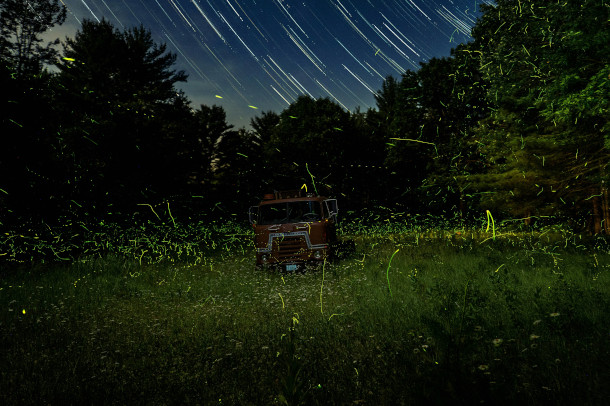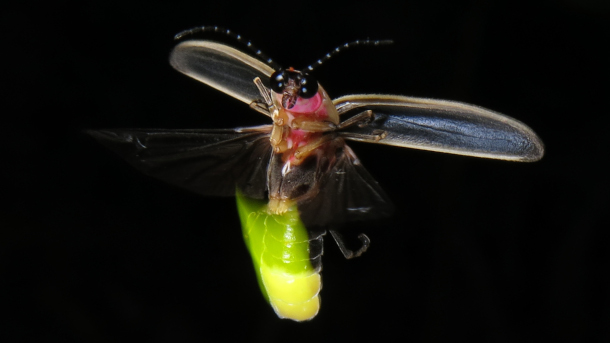Fireflies at Risk
Air Date: Week of August 8, 2025

This timelapse, taken over the course of 30 minutes, shows fireflies in a Wisconsin field. (Photo: Robert Ritchie, Unsplash)
The summertime magic of fireflies lighting up at dusk is facing threats because of climate change and habitat destruction. Living on Earth’s Ashanti Mclean shares with Hosts Aynsley O’Neill and Paloma Beltran a few tips that can help to protect firefly species.
Transcript
BELTRAN: It’s Living on Earth, I’m Paloma Beltran.
O’NEILL: I’m Aynsley O’Neill. It’s summer here in the States, and if you’re outside at night, you might be lucky enough to spot one of the most magical creatures that this season has to offer. We’re talking fireflies; they hold a really special place in many people’s hearts. For me, Paloma, I grew up seeing little lightning bugs in the yard every summer. How about you?
BELTRAN: You know Aynsley, not really, they’re not present in Mexicali due to its desert climate. But I did get a chance to catch them in the East Coast and in the state of Mexico. Should, though, hold on tight to these memories, because scientists say many fireflies are in decline. Living on Earth’s Ashanti Mclean has been looking into why their numbers are dropping and how we can protect them. She’s here with us now. Hey, Ashanti, how are you?
MCLEAN: Hey Paloma, I’m doing great. Just enjoying the rest of summer and excited to chat about some fireflies today!
O’NEILL: Okay, well, so first off, Ashanti, where can we find these creatures? You know, how wide-reaching are they?
MCLEAN: Yeah, they're really all over the states, and they can even reach up into Canada or down to Mexico, like Paloma mentioned. But you can really spot them the most in the eastern range of the US.
BELTRAN: And you know what’s really lovely about them is their glow. How do they make that happen?
MCLEAN: It’s pretty fascinating if you ask me. Some of the beetles produce light through a chemical reaction in their abdomens known as bioluminescence. And you can even see different colors and patterns based on things like species, temperature, or even the time of night that you spot them.
O’NEILL: And Ashanti, since we’re hearing that these bugs are in decline, just how serious is this problem?
MCLEAN: Well, there are over 100 firefly species in the U.S. alone, and roughly 2,000 around the world. But a recent study published by Science Direct reports a gradual drop among 18 species across North America.

A close-up of a glowing firefly. (Photo: terry priest, Flickr, CC BY-SA 2.0)
O’NEILL: Oh, wow. That’s not nothing. I mean, just from personal experience, I feel like I see fewer and fewer fireflies as I get older.
MCLEAN: Well, I hate to admit I’ve seen pretty few so far, but summer’s not over yet, so I’m still crossing my fingers. And I actually learned that fireflies tend to be super localized, so sometimes one group may have lost its habitat, but you can still find others nearby. Ongoing environmental threats are what’s really putting these species at risk. Basically, residential and commercial development have degraded the very wetlands that they need most to thrive, not to mention climate change drying up that moisture as well.
BELTRAN: Yikes, and I’ve heard that the best thing for fireflies is actually to leave them alone, but what else can we do, Ashanti?
MCLEAN: Well, for starters, we have to keep in mind that protecting the habitat is a top priority. So it can help to do things like planting shrubs, leaving leaves behind after raking, and avoiding the use of pesticides. And yes, it’s better to keep fireflies as a light show rather than as a pet in a jar. So don’t forget to turn off your porch lights to get a better glimpse of their glow!
O’NEILL: Yes, very good point. Thank you for bringing us this report, Ashanti. It’s always good to get a little appreciation for these little lightning bugs.
BELTRAN: Yeah, and it’s good to know what we can do to help! Thanks, Ashanti.
MCLEAN: Thanks, Paloma. Thanks, Aynsley.
Links
Yale E360 | “A Summer Light Show Dims: Why Are Fireflies Disappearing?”
Grist | “Seeing Fewer Fireflies This Year? Here’s Why, and How You Can Help.”
Living on Earth wants to hear from you!
Living on Earth
62 Calef Highway, Suite 212
Lee, NH 03861
Telephone: 617-287-4121
E-mail: comments@loe.org
Newsletter [Click here]
Donate to Living on Earth!
Living on Earth is an independent media program and relies entirely on contributions from listeners and institutions supporting public service. Please donate now to preserve an independent environmental voice.
NewsletterLiving on Earth offers a weekly delivery of the show's rundown to your mailbox. Sign up for our newsletter today!
 Sailors For The Sea: Be the change you want to sea.
Sailors For The Sea: Be the change you want to sea.
 The Grantham Foundation for the Protection of the Environment: Committed to protecting and improving the health of the global environment.
The Grantham Foundation for the Protection of the Environment: Committed to protecting and improving the health of the global environment.
 Contribute to Living on Earth and receive, as our gift to you, an archival print of one of Mark Seth Lender's extraordinary wildlife photographs. Follow the link to see Mark's current collection of photographs.
Contribute to Living on Earth and receive, as our gift to you, an archival print of one of Mark Seth Lender's extraordinary wildlife photographs. Follow the link to see Mark's current collection of photographs.
 Buy a signed copy of Mark Seth Lender's book Smeagull the Seagull & support Living on Earth
Buy a signed copy of Mark Seth Lender's book Smeagull the Seagull & support Living on Earth

